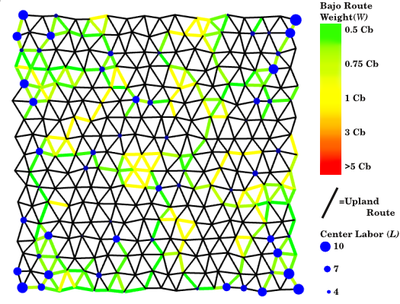CHAAHK: a Spatial Simulation of the Maya Elevated Core Region (1.0.0)
This thesis presents an abstract spatial simulation model of the Maya Central Lowlands coupled human and natural system from 1000 BCE to the present day. It’s name is the Climatically Heightened but Anothropogenically Achieved Historical Kerplunk model (CHAAHK). The simulation features features virtual human groups, population centers, transit routes, local resources, and imported resources. Despite its embryonic state, the model demonstrates how certain anthropogenic characteristics of a landscape can interact with externally induced trauma and result in a prolonged period of relative sociopolitical uncomplexity. Analysis of batch simulation output suggests decreasing empirical uncertainties about ancient wetland modification warrants more investment. This first submission of CHAAHK’s code represents the simulation’s implementation that was featured in the author’s master’s thesis.

Release Notes
This is the initial release of the code done in order to archive the model’s exact implementation that was analyized for the author’s master’s thesis. Future updates will follow, hopefully quickly, that provide more commenting and general cleaning up.
This code is protected under the MIT license, but the website will not allow me to proceed if I select this option.
Associated Publications
This release is out-of-date. The latest version is
1.1.0
CHAAHK: a Spatial Simulation of the Maya Elevated Core Region 1.0.0
Submitted by
Alex Kara
Published Dec 04, 2018
Last modified Sep 26, 2019
This thesis presents an abstract spatial simulation model of the Maya Central Lowlands coupled human and natural system from 1000 BCE to the present day. It’s name is the Climatically Heightened but Anothropogenically Achieved Historical Kerplunk model (CHAAHK). The simulation features features virtual human groups, population centers, transit routes, local resources, and imported resources. Despite its embryonic state, the model demonstrates how certain anthropogenic characteristics of a landscape can interact with externally induced trauma and result in a prolonged period of relative sociopolitical uncomplexity. Analysis of batch simulation output suggests decreasing empirical uncertainties about ancient wetland modification warrants more investment. This first submission of CHAAHK’s code represents the simulation’s implementation that was featured in the author’s master’s thesis.
Release Notes
This is the initial release of the code done in order to archive the model’s exact implementation that was analyized for the author’s master’s thesis. Future updates will follow, hopefully quickly, that provide more commenting and general cleaning up.
This code is protected under the MIT license, but the website will not allow me to proceed if I select this option.

